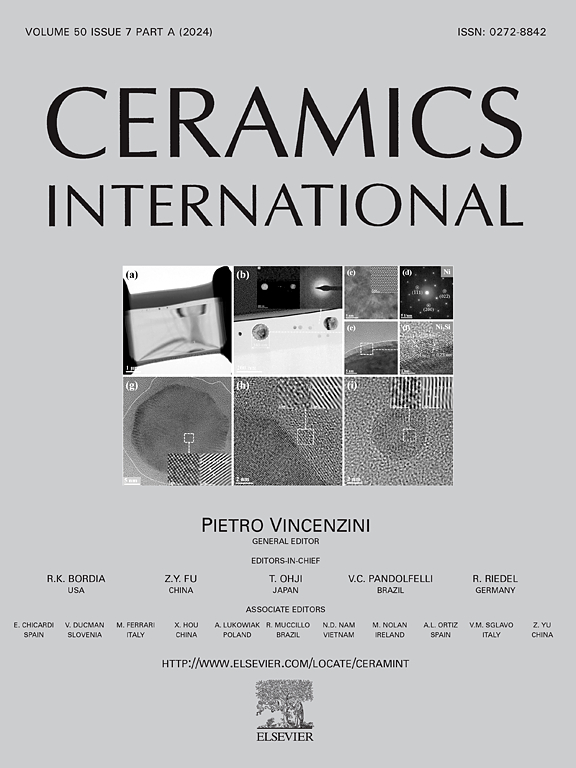Reducing the FMR Linewidth of high-dielectric-constant BiZr-YIG ferrites by adjusting the pre-sintering temperature
IF 5.6
2区 材料科学
Q1 MATERIALS SCIENCE, CERAMICS
引用次数: 0
Abstract
Reducing the ferromagnetic resonance (FMR) linewidth of high-dielectric-constant yttrium iron garnet (YIG) ferrites is beneficial for the miniaturization of microwave devices. This study systematically investigated the phase evolution, microstructure, dielectric spectra, hysteresis loops, and FMR linewidth of BiZr-YIG ferrites at different pre-sintering temperatures (Tp), elucidating the mechanisms by which pre-sintering temperature affects its electromagnetic properties. Adjusting the pre-sintering temperature enhanced the densification of the BiZr-YIG ferrites. This adjustment led to a 65 % reduction in FMR linewidth while further increasing the relative dielectric constant. The saturation magnetization remained stable at approximately 27.00 emu/g. At Tp = 1000 °C, the BiZr-YIG ferrites exhibited a high relative dielectric constant (εr = 22.50), stable saturation magnetization (Ms = 27.09 emu/g), and a narrow FMR linewidth (ΔH = 92.37 Oe). These results indicate that adjusting the pre-sintering temperature to optimize the phase formation and crystallinity of the pre-sintered powder is highly valuable for reducing the FMR linewidth of high-dielectric-constant YIG ferrites, promoting its application in the miniaturization of microwave devices.
通过调节预烧结温度来减小高介电常数BiZr-YIG铁氧体的FMR线宽
减小高介电常数钇铁石榴石铁氧体的铁磁共振线宽有利于微波器件的小型化。本研究系统研究了不同预烧结温度(Tp)下BiZr-YIG铁氧体的相演化、微观结构、介电谱、磁滞回线和FMR线宽,阐明了预烧结温度影响其电磁性能的机理。调整预烧结温度可以增强BiZr-YIG铁氧体的致密性。这种调整导致FMR线宽减少65%,同时进一步增加相对介电常数。饱和磁化强度稳定在27.00 emu/g左右。在Tp = 1000℃时,BiZr-YIG铁氧体具有较高的相对介电常数(εr = 22.50)、稳定的饱和磁化强度(Ms = 27.09 emu/g)和较窄的FMR线宽(ΔH = 92.37 Oe)。结果表明,调整预烧结温度,优化预烧结粉末的相形成和结晶度,对于减小高介电常数YIG铁氧体的FMR线宽,促进其在微波器件小型化中的应用具有重要意义。
本文章由计算机程序翻译,如有差异,请以英文原文为准。
求助全文
约1分钟内获得全文
求助全文
来源期刊

Ceramics International
工程技术-材料科学:硅酸盐
CiteScore
9.40
自引率
15.40%
发文量
4558
审稿时长
25 days
期刊介绍:
Ceramics International covers the science of advanced ceramic materials. The journal encourages contributions that demonstrate how an understanding of the basic chemical and physical phenomena may direct materials design and stimulate ideas for new or improved processing techniques, in order to obtain materials with desired structural features and properties.
Ceramics International covers oxide and non-oxide ceramics, functional glasses, glass ceramics, amorphous inorganic non-metallic materials (and their combinations with metal and organic materials), in the form of particulates, dense or porous bodies, thin/thick films and laminated, graded and composite structures. Process related topics such as ceramic-ceramic joints or joining ceramics with dissimilar materials, as well as surface finishing and conditioning are also covered. Besides traditional processing techniques, manufacturing routes of interest include innovative procedures benefiting from externally applied stresses, electromagnetic fields and energetic beams, as well as top-down and self-assembly nanotechnology approaches. In addition, the journal welcomes submissions on bio-inspired and bio-enabled materials designs, experimentally validated multi scale modelling and simulation for materials design, and the use of the most advanced chemical and physical characterization techniques of structure, properties and behaviour.
Technologically relevant low-dimensional systems are a particular focus of Ceramics International. These include 0, 1 and 2-D nanomaterials (also covering CNTs, graphene and related materials, and diamond-like carbons), their nanocomposites, as well as nano-hybrids and hierarchical multifunctional nanostructures that might integrate molecular, biological and electronic components.
 求助内容:
求助内容: 应助结果提醒方式:
应助结果提醒方式:


